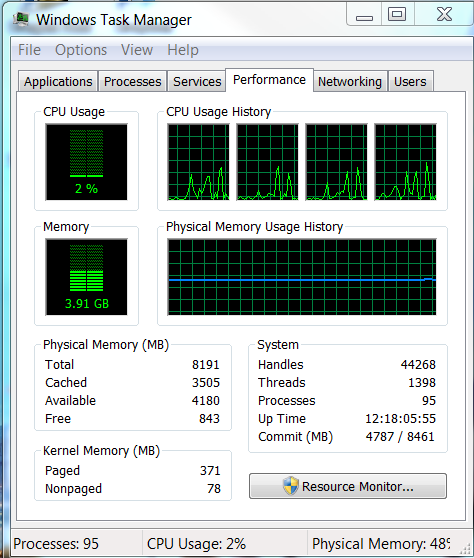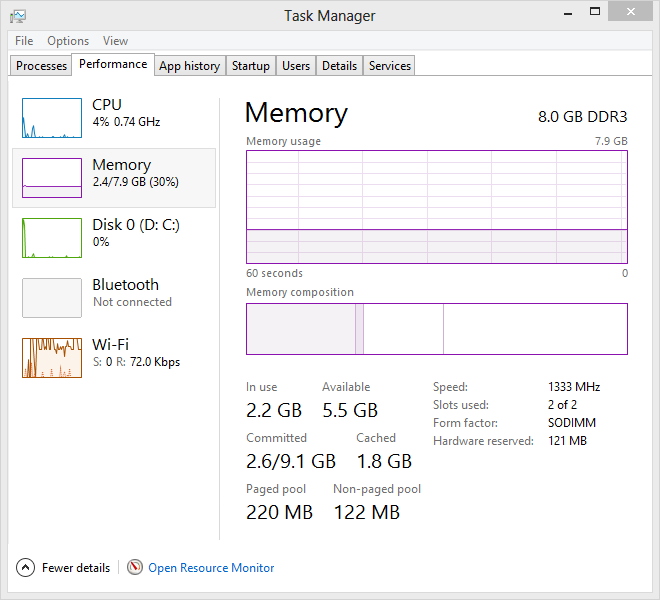| ウェブサイトをできるだけ多くの言語で地域化しようとしていますが、このページは現在Google Translateにより機械翻訳されています。 | 終了 |
-
-
製品
-
資料
-
サポート
-
会社
-
利用でき、空き物理メモリの違いは何ですか?What is the difference between available and free physical memory?
バイ Davide De Vellis 11月 28, 2013computer performance, memory, slow pc, upgrade, windows, Windows 7, windows 8, windows vista, Windows XP2 Commentsコンピュータの速度が低下し始めると、何らかの原因でこの問題が発生する可能性があります。トラブルシューティングを行うと、しばしば原因を特定できます。 ReviverSoft Blogには、自分でやりたいと思っているだけでなく、私たちのウェブサイトに多数の製品を用意しています。このトラブルシューティングプロセスを経ることで、メンテナンスや最適化で問題を解決できるかどうか、安価なアップグレードを行うか、新しいコンピュータシステム全体に投資するかどうかを判断できます。
しばしば誤解されている概念は、システムにどれくらいのメモリがあり、どのようにこれがコンピュータのパフォーマンスに影響するかということです。あなたのタスクマネージャーを見つけることは、始めるのに適しています。とりわけ、メモリとプロセッサの使用状況が一覧表示されます。これらの値が100%に近づくにつれて、システムの速度が低下したり、動作が停止したりします。残念なことに、Windowsが提供するメッセージは、やや秘密にすることができます。たくさんのオプションがあるので、実際に使用しているメモリ量を調べてみましょう。

“Ctrlキーを押しながら” Alt “+” Del “を押してタスクマネージャにアクセスして、メモリ使用量などのさまざまなシステムの状態をチェックします。さまざまなオプションを分解することで、何が起こっているのかを理解するのがずっと簡単になります。
合計メモリ。これはあなたのコンピュータにインストールされている量です。今日、メモリはギガバイト(GB)単位で販売されています。画面にメガバイト(MB)が表示されている場合は、千の列の数値を使用してどれだけ持っているかを確認してください。メモリを購入する必要がある場合、これは手元にある最も重要な番号の1つです。
キャッシュされたこれは物事が混乱することができる場所です。記憶の目的は、物事をより迅速にアクセスできるようにすることです。この目的のために、Windowsはアイテムをまだメモリにロードしていませんが、それは後である可能性があります。これはキャッシュメモリです。それにはものがありますが、あなたのプログラムの1つが必要な場合は空にすることができます。
無料。これは実際に空のメモリです。想像しておいたように、このスペースは、キャッシュを追加したり、プログラムに直接使用することができます。この数値が予想よりも小さい場合は心配しないでください。プログラムを実行するために実際に使用できるメモリのすべてではありません。
利用可能です。これはあなたが探している番号です。これがゼロになると、あなたのシステムは非常に不幸になります。より詳しく調べると、この数値はキャッシュメモリと空きメモリを足したもの(わずかにマイナス)に等しいことがわかります。これは、キャッシュされたメモリのすべてを即座にダンプ(または解放)できるわけではないためです。それは実際には少なくとも実際に呼び出される可能性があります。
コミット/ページファイル。 Windowsは実際にあなたのハードディスクを少し使い、あなたのメモリをより良く管理します。アクティブなアイテムがより高速な物理メモリを使用できるように、ここではすぐには必要のないアイテムを配置します。プログラムは実際には使用しない場合でもコミットされたメモリの大きなチャンクを要求することが多いため、これは心配するものではありません。

“Widows 8タスクマネージャにはシステムメモリに関する同様の情報があります”これらの数字のそれぞれが何を意味しているかを知ったので、メモリと使用に関するシステムがどこにあるのかをすぐに知ることができます。多くのプログラムを実行している場合は、いつでも簡単に閉じることができます。一方、最も簡単なプログラムを実行していてもほとんどすべてのリソースを占有している場合は、メモリアップグレードまたは新しいシステム全体をチェックする時間がかかるかもしれません。
Was this post helpful?YesNo
あなたの答えを見つけられませんでした?世界中からの専門家の私たちのコミュニティに質問をする、全く時間がないの答えを受け取る。most relevant 最近の記事 Pinterestにピン留めする